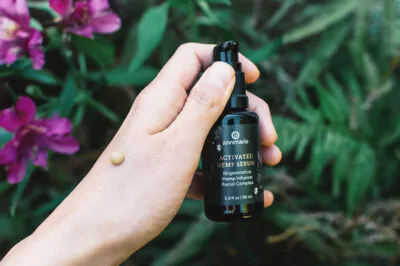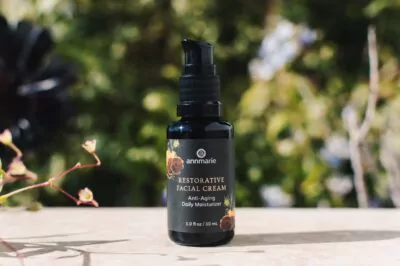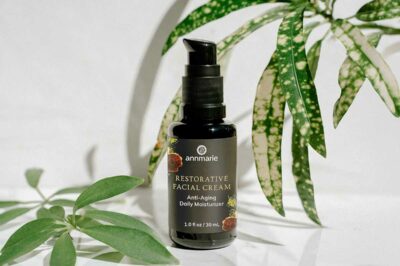Face cleanser. You scrub it on and rinse it off. Surely in those 30 seconds it can’t harm your skin, right?
Think again. While it’s true that rinseoff products don’t sit on your skin as long as things like, say, moisturizers—limiting your exposure to potentially harmful chemicals—that’s only part of the story. The simple act of cleaning your face could set you up for premature aging.
In fact, you may be surprised to learn that your cleanser is the most important product in your skin care regimen. Before you put on your facial oil, moisturizer or your anti-aging treatment, you need clean, refreshed skin, or that next product just won’t work as well.
Unfortunately, many of today’s popular cleansers not only fail to clean well, but they can actually damage your skin, encouraging dryness, dullness, and the appearance of fine lines and wrinkles.
Your cleanser could be aging your skin!
What is pH?
You’ve probably heard about pH balance in the skin, and how some products can disrupt it. But what is pH balance?
Travel back in time to your high school chemistry class and you may remember that pH means “potential hydrogen.” (Don’t feel badly if you don’t—most of us were snoozing.) Scientifically, it measures the hydrogen ions in a concentration. You can think of it as an abbreviation for “power of hydrogen.” More simply, it’s a measurement of the acid-alkaline ratio of something, which ranges from 0 (the most acidic) to 14 (the most alkaline).
The number “7” is considered the midpoint. Anything above 7 is more alkaline, and anything below more acidic. Those elements with a pH of 7 are considered neutral—like pure water, which has a pH of 7.
Some other little examples:
- Milk of magnesia is an alkaline substance with a pH of 10, which is why it helps soothe an acidic stomach. Any time you bring substances at opposite ends of the scale together, they can help balance each other.
- Vinegar has a pH of 3, making it more acidic than water. This is why it helps dissolve things like hard water deposits.
- Soda pop has a pH of 2.5, making it more acidic—which is why it can wear away your tooth enamel.
- Baking soda is highly alkaline, and can help balance out acidic substances.
Best Facial Cleanser: Gel or Cream?
Our Favorite Balancing Natural Face Wash; Citrus Mint Facial Cleanser
The pH Balance of Your Skin
What does pH balance have to do with your skin? Like most things, your skin has a preferred pH level where it is most healthy and vibrant. The skin’s outer layer, for example—which keeps in lipids and moisture—works best when it’s slightly acidic, at a 5.5 pH level.
When the outer layer is too alkaline, it gets dry and sensitive, which can lead to fine lines, wrinkles, dullness, and even skin problems.
A 2010 study published in the British Journal of Dermatology reported that after eight years, women with an alkaline outer layer developed more fine lines and crow’s feet and were more prone to damage than those with more acidic skin.
On the other hand, skin that is too acidic isn’t happy either. It’s likely to respond with increased breakouts, and may feel raw, irritated, and sore.
On Which Side Are You?
Balancing skin pH is a great way to delay the signs of aging and encourage vibrant, youthful looking skin. Unfortunately, many of us mess up the pH balance first thing in the morning when we clean our faces, setting the stage for premature aging.
Even if you’re doing everything else you’re supposed to do, including applying sunscreen, facial oil or moisturizer, and anti-aging treatments, if you don’t have the right cleanser, you could be wasting your money!
How can you tell if your skin is off balance? Look for these clues:
Too acidic
• Your skin feels oily and not thoroughly clean after cleansing
• You rarely need or apply moisturizer
• Your skin is reactive and sensitive to products
• Your skin often looks red and feels irritated
• You have a greasy look
Too alkaline
• Your skin feels tight and dry after cleansing
• You need to apply moisturizer more than once a day
• You sometimes experience dry, rough patches
• Your skin usually looks dull with more lines first thing in the morning
• Your skin may sting or feel irritated after applying products
• Your skin rarely appears plump or dewy
Determining which side your skin is on can help you discover what’s going wrong in your skin care. Of course, if your skin is vibrant, dewy, and perfectly moisturized, you’re well balanced and have nothing to worry about. Very few of us fall into that category, however!
A Delicate Balance
Why is your cleanser so important to your skin’s pH? Because surfactants—the ingredients in your cleanser that clean skin—can easily disrupt the pH. Soap that is too alkaline, for example, can break up the acid in your skin, causing dryness. That’s why we recommend you don’t use soap to clean your skin as most are too drying with pH levels between 9-12. Once you disrupt your skin’s pH with soap, it can take hours to restore itself, leaving your skin vulnerable to aging during that time.
The pH level of most cleansers is slightly higher than 5.5—your skin’s preferred level—so they can break down dirt and oil. They have to be slightly different to be effective, but the balance is critical. Those that are too alkaline may get your skin clean, but they will also strip your skin of its natural oils, causing dryness, dullness, irritation, and wrinkles.
There is a very fine line between creating the perfect cleanser one to be completely balanced and in harmony with your skin. Start using the right cleanser now, and you will be on your way to beautiful healthy skin. Oh, and by the way—ignore the words “pH balanced” on a product. It’s just marketing hype, as most soap-free cleansers are pH balanced.
How can you tell if a product will clean your skin without damaging it? The next step—watch out for harsh ingredients.
Harsh Chemical Ingredients
We talked about sodium laureth sulfate and sodium lauryl sulfate in a former post. These are two popular ingredients used in skin care products, but they’re too harsh and drying. Their pH levels are around 10, which means they can strip the skin’s natural oils and create dryness, particularly if you use them every day.
On the other hand, ingredients like alpha hydroxy acids and amino fruit acids can help exfoliate and deep clean, but they can also be overly acidic, which can disrupt the lipid barrier in skin and even weakens skin’s natural defenses to environmental pollution.
Another popular ingredient in cleansers is the antibacterial and antifungal agent, Triclosan. In 1972, when Triclosan first came into the market, it was solely used in hospitals and healthcare settings. But since then it has slowly made it’s way into most common household products and many cosmetic products. From Beyond Pesticides Group: “Studies have increasingly linked triclosan (and its chemical cousin triclocarban), to a range of adverse health and environmental effects from skin irritation, endocrine disruption, bacterial and compounded antibiotic resistance, to the contamination of water and its negative impact on fragile aquatic ecosystems.”
Finding Balance
Looking at the ingredient deck on your products will help you choose more nourishing, tender cleansers. The best gauge for how your products are working, however, is your skin! If it feels dry, dull, and irritated, your cleanser may be too alkaline. If it’s oily, red, sensitive, or breaking out, your cleanser may be too acidic.
Note that you’ll likely find differences in your skin as you age, as well. What worked for you when you were in your 20s probably won’t work as well anymore. Skin naturally gets dryer as we age, as it doesn’t produce as much natural oil. The outer layer also becomes damaged, and is less able to hold onto moisture.
Protect and Restore with Anti-Aging Cleanser
It all comes down to a delicate balance between you, your skin, and your products. At Annmarie Skin Care, we use nourishing plant ingredients that clean your skin without being too harsh or too drying. Our cleansers also include protective antioxidants and restorative moisturizers.
When you start your day off with a perfectly balanced cleanser, like our Citrus Mint Cleanser or Aloe Herb Cleanser, you’re helping your skin to appear more vibrant and smooth while keeping it clean and refreshed.
While most cleansers for oily skin strip the excess oil with each use, the Citrus Mint Cleanser helps to balance oil production over time. It’s important to understand the role of pH in your skin care to choose the best anti-aging products for your skin! And more importantly, you’ll also need to know how to properly cleanse your face to further prevent damages to your skin.








Hi there,
Great article!
In the clues of acidic / alkaline skin, I found that I had a few factors of both?
My skin can be reactive and sensitive to (certain) products, it is very oily and prone to breakouts (but this is heavily dependent on other factors like diet), I have a greasy look
Yet
I get dry patches, my skin may sting or after applying (certain) products and it always feels tight and dry after cleansing
I currently use ACV diluted with water to cleanse twice daily, nothing has changed (in the way my skin acts / reacts)
What do you suggest in this case?
Wonderful explanation of the skin’s pH! It’s good to know that you have taken great care to keep our skin balanced with your products. That’s why they work so well without stripping the skin. Xo
Excellent article. Super information for us all. Also the aloe vera is one of the ingredients that is helps immensely to repair the skin after it is burned by the sun or hospital treatments. Good choice for your cleanser. Thank you.
So happy you enjoyed the article. Thank you Judy, we just love Aloe in all it’s forms :). And it is so silky in our cleanser and leaves skin radiant. Make it a wonder-filled day :).
I know for a fact that the Aloe Herb cleanser has totally brought my skin back to it’s proper balance and my once extremely uncomfortably dry skin is now normal!:) Thank you Annmarie!!